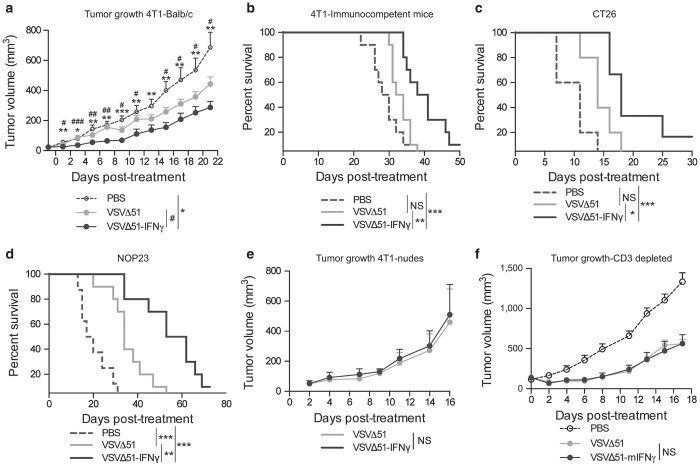Figure 6.
VSVΔ51-IFNγ demonstrates better efficacy compared to the parental virus. (a) Tumor volumes of 4T1 fat-pad tumors of mice treated with phosphate-buffered saline (PBS), VSVΔ51 or VSVΔ51-IFNγ (n = 9 or 10). The animals were treated daily when the average tumor diameter reached 5 mm, for a total of five injections (first dose IV and subsequent doses IT). Mice were sacrificed when they reached end-point. NS: P > 0.1, *P < 0.1, **P < 0.01, ***P < 0.001 (unpaired one-tailed T-test). (b) Kaplan-Meier survival curves were generated from the same experiment. (c) and (d) Kaplan-Meier survival curves of CT26 and NOP23 tumor-bearing mice treated or not with VSVΔ51 or VSVΔ51-IFNγ. The CT26 tumor-bearing animals were treated daily with three injections (first dose IV and subsequent doses IT) and the NOP23 tumor-bearing animals were treated IT every second day starting at day 18 for a total of six injections. (e) Tumor volumes of 4T1 fat-pad tumors of nude mice treated with VSVΔ51 or VSVΔ51-IFNγ (n = 5). The animals were treated daily when the average tumor diameter reached 5 mm, for a total of five injections (first dose IV and subsequent doses IT). (f) Tumor volumes of 4T1 fat-pad tumors of Balb/c mice treated with PBS or either viruses following T-cell depletion (n = 7). T cells were depleted when the average tumor diameter reached 5 mm and the virus treatment started 24 hours later, for a total of five injections (first dose IV and subsequent doses IT). For survival experiments; NS: P > 0.1, *P < 0.1, **P < 0.01, ***P < 0.001 (Mantel-Cox test).

